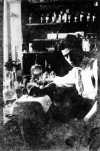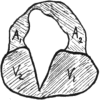Brief history of arrhythmia in the WPW syndrome - the contribution of George Ralph Mines
- PMID: 23858007
- PMCID: PMC3779102
- DOI: 10.1113/jphysiol.2013.259598
Brief history of arrhythmia in the WPW syndrome - the contribution of George Ralph Mines
Abstract
George Ralph Mines studied the basic principles of reentry and published his data in The Journal of Physiology in 1913. Exactly 100 years later we discuss his first electrophysiological experiments and how his results lead to the insight that was the basis for the treatment of the clinical arrhythmias seen in Wolff-Parkinson-White syndrome.
Figures




References
-
- Aanhaanen WT, Moorman AF, Christoffels VM. Origin and development of the atrioventricular myocardial lineage: insight into the development of accessory pathways. Birth Defects Res A Clin Mol Teratol. 2011b;91:565–577. - PubMed
-
- Anderson RH, Becker AE. Stanley Kent and accessory atrioventricular connections. J Thorac Cardiovasc Surg. 1981;81:649–658. - PubMed
-
- Anderson RH, Becker AE, Brechenmacher C, Davies MJ, Rossi L. Ventricular preexcitation. A proposed nomenclature for its substrates. Eur J Cardiol. 1975;3:27–36. - PubMed
-
- Becker AE, Anderson RH. The Wolff–Parkinson–White syndrome and its anatomical substrates. Anat Rec. 1981;201:169–177. - PubMed
Publication types
MeSH terms
Personal name as subject
- Actions
LinkOut - more resources
Full Text Sources
Other Literature Sources
Medical

